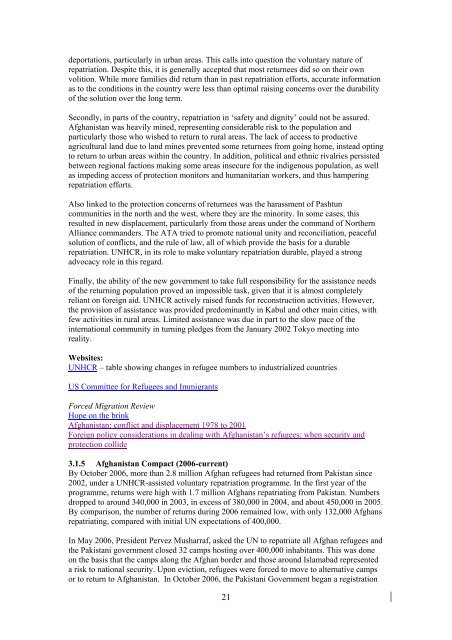Afghanistan. - Forced Migration Online
Afghanistan. - Forced Migration Online
Afghanistan. - Forced Migration Online
Create successful ePaper yourself
Turn your PDF publications into a flip-book with our unique Google optimized e-Paper software.
deportations, particularly in urban areas. This calls into question the voluntary nature of<br />
repatriation. Despite this, it is generally accepted that most returnees did so on their own<br />
volition. While more families did return than in past repatriation efforts, accurate information<br />
as to the conditions in the country were less than optimal raising concerns over the durability<br />
of the solution over the long term.<br />
Secondly, in parts of the country, repatriation in ‘safety and dignity’ could not be assured.<br />
<strong>Afghanistan</strong> was heavily mined, representing considerable risk to the population and<br />
particularly those who wished to return to rural areas. The lack of access to productive<br />
agricultural land due to land mines prevented some returnees from going home, instead opting<br />
to return to urban areas within the country. In addition, political and ethnic rivalries persisted<br />
between regional factions making some areas insecure for the indigenous population, as well<br />
as impeding access of protection monitors and humanitarian workers, and thus hampering<br />
repatriation efforts.<br />
Also linked to the protection concerns of returnees was the harassment of Pashtun<br />
communities in the north and the west, where they are the minority. In some cases, this<br />
resulted in new displacement, particularly from those areas under the command of Northern<br />
Alliance commanders. The ATA tried to promote national unity and reconciliation, peaceful<br />
solution of conflicts, and the rule of law, all of which provide the basis for a durable<br />
repatriation. UNHCR, in its role to make voluntary repatriation durable, played a strong<br />
advocacy role in this regard.<br />
Finally, the ability of the new government to take full responsibility for the assistance needs<br />
of the returning population proved an impossible task, given that it is almost completely<br />
reliant on foreign aid. UNHCR actively raised funds for reconstruction activities. However,<br />
the provision of assistance was provided predominantly in Kabul and other main cities, with<br />
few activities in rural areas. Limited assistance was due in part to the slow pace of the<br />
international community in turning pledges from the January 2002 Tokyo meeting into<br />
reality.<br />
Websites:<br />
UNHCR – table showing changes in refugee numbers to industrialized countries<br />
US Committee for Refugees and Immigrants<br />
<strong>Forced</strong> <strong>Migration</strong> Review<br />
Hope on the brink<br />
<strong>Afghanistan</strong>: conflict and displacement 1978 to 2001<br />
Foreign policy considerations in dealing with <strong>Afghanistan</strong>’s refugees: when security and<br />
protection collide<br />
3.1.5 <strong>Afghanistan</strong> Compact (2006-current)<br />
By October 2006, more than 2.8 million Afghan refugees had returned from Pakistan since<br />
2002, under a UNHCR-assisted voluntary repatriation programme. In the first year of the<br />
programme, returns were high with 1.7 million Afghans repatriating from Pakistan. Numbers<br />
dropped to around 340,000 in 2003, in excess of 380,000 in 2004, and about 450,000 in 2005.<br />
By comparison, the number of returns during 2006 remained low, with only 132,000 Afghans<br />
repatriating, compared with initial UN expectations of 400,000.<br />
In May 2006, President Pervez Musharraf, asked the UN to repatriate all Afghan refugees and<br />
the Pakistani government closed 32 camps hosting over 400,000 inhabitants. This was done<br />
on the basis that the camps along the Afghan border and those around Islamabad represented<br />
a risk to national security. Upon eviction, refugees were forced to move to alternative camps<br />
or to return to <strong>Afghanistan</strong>. In October 2006, the Pakistani Government began a registration<br />
21
















